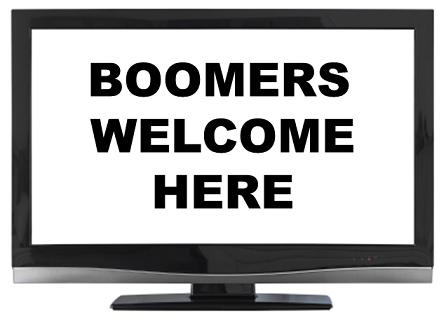If I showed you the average age of the audiences for three historic radio brands, what would be your prognosis?
Station A 57.8
Station B 53.3
Station C 50.8
You would probably tell me that all three are over the “demographic cliff,” that they’ve already aged themselves out of most major media buys, and that they’re probably in deep trouble.
But they’re not radio stations, they’re TV networks – CBS, ABC, and NBC, to be precise – and they’re anything but troubled. In fact, you could make the case they continue to be in great financial shape.
Now Fox and CW are younger, positioned in the early 40’s. And all five networks compete hard for 18-49 viewers. But the fact is that they are viable, vibrant networks in spite of the fact that for the so-called “Big 3,” their average viewer is a Baby Boomer.
They also continue to crank out new programming at an amazing clip. Not all of it works, of course. In fact, most new shows don’t make it. But that doesn’t stop the TV networks from innovation, risk-taking, and creativity because they all know that having something new to talk about is paramount for both consumers and ad agencies.
 Now segue over to radio, and let’s take a look at why the model is so different. We have allowed advertisers (at least on the national front) to trap us into the 25-54 center. As a result, marketing dollars targeted under 25 or over 54 go elsewhere – mostly to digital and television.
Now segue over to radio, and let’s take a look at why the model is so different. We have allowed advertisers (at least on the national front) to trap us into the 25-54 center. As a result, marketing dollars targeted under 25 or over 54 go elsewhere – mostly to digital and television.
Think about the base of advertisers that are truly looking to reach Boomers. Drug companies are a great example. There is an endless reservoir of commercials for every conceivable drug, and it’s virtually impossible to turn on a TV and not bump into several.
Boomers buy half of new cars sold, and as our research has clearly shown, they have an even stronger propensity to purchase or lease “connected cars.” But again, we’re not selling and they’re not buying.
It’s not there’s a lack of 50+ dollars. It’s that there’s a lack of positioning by radio that we’re a viable, efficient, and effective way to reach them. They are the least digital of the generations, which translates to making them the perfect target for radio.
We often talk about radio’s need to go after more digital dollars, and if any company understands the potential and the reality of that space, we do. But it’s also a fact that there’s an incredible market for gray hairs with money to spend on a wide array of products – if we had the courage and foresight to go after them.
Instead, we spend more time “fixing” our formats to make them more 25-54 compatible. And in the process, we hurt our brands and walk away from dollars at a time when a recovering economy and Boomers with cash could power radio to double-digit growth.
Imagine that.
- What To Do If Your Radio Station Goes Through A Midlife Crisis - April 25, 2025
- A 2020 Lesson?It Could All Be Gone In A Flash - April 24, 2025
- How AI Can Give Radio Personalities More…PERSONALITY - April 23, 2025




Fred, great perspective. In the research we did with Arbitron and the University of Wisconsin into the PPM panelist data, it was clear that the vast majority of listening is driven by full-time working adults. In fact, the highest over-indexing listening comes from Full-time, working, 45+ listeners….aka Boomers with cash. Bottom line: there is no more efficient and effective way to target and reach these full-time-working engines of the local economy than with radio. As you point out so well above, it’s one of radio’s most powerful stories and best targets.
Tripp, thanks for backing up my qualitative claims with some quantitative data. Thanks for chiming in and reading our blog.
Why not just ask them?
Radio used to have the same problem with 12-34 and IIRC advertiser fixation on using TV to reach them was one of the major drivers that led radio to focus on 25-54. Radio never bothered to ask those advertisers why that was, or what radio could do to make itself more attractive as a vehicle to reach them.
I’ve dealt with big Pharma in other media and here’s my take: They are over-layered with agencies for every little aspect of marketing, making it difficult to isolate real decision makers and even harder to coax an answer out of one before they get moved to another brand. But there is tons ‘o money there and if radio was willing to do some hard work and be patient, big pharma could potentially be an important revenue category.
Absolutely, Bob. And those omnipresent commercials for Claritin, Cialis, and every other wonder drug are perfect for radio audiences. Not to mention personality endorsers. Radio has spent decades having its DJs get hair transplants, boob jobs, and participate in all kinds of diet programs from Weight Watchers to Nutri System. There are millions of Boomer dollars out there and radio has incredible efficiencies and great stations. Appreciate the comment.